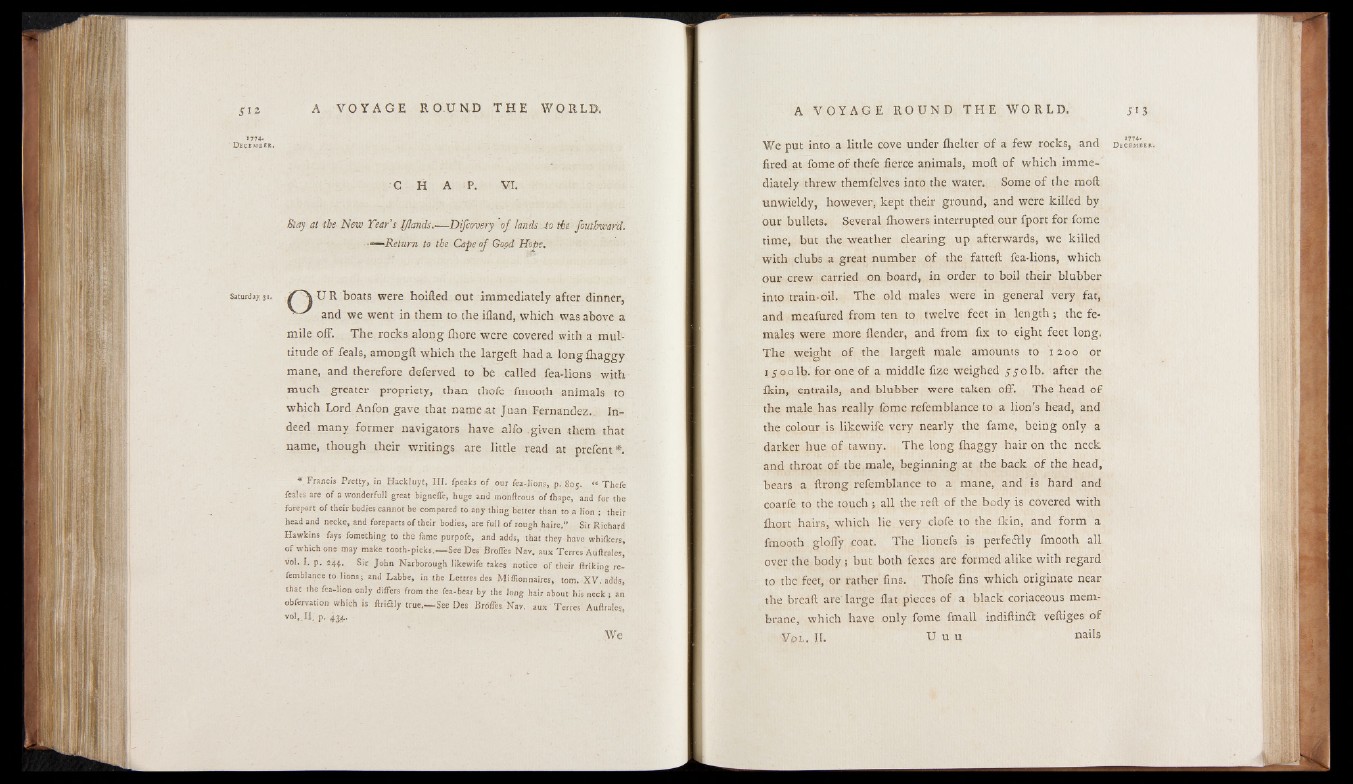
{M
1774-
D e c e m b e r «
Saturday, 31.
C H A P. VI.
Stay at the- New Tear’s IJlands.— Difcovery of lands-to the fouthward.
— Return to the Cape of Good Hope.
I^ Y U R boats were hoifted out immediately after dinner,
and we went in them to the ifland, which was above a
mile off. The rocks along Ihore were covered with a multitude
of feals, amongft which the largeft had a long fhaggy
mane, and therefore deferved to be called fea-lions with
much greater propriety, than thofe fmooth animals to
which Lord Anfon gave that name at Juan Fernandez.. Indeed
many former navigators have alfo given them that
name, though their writings are little read at prefent*.
«.Francis Pretty, in Hackluyt, III. fpeaks of our fea-lions, p. 805. “ Thefe
feales are of a wonderfull great bigneffe, huge and'monftrous of fhape, and for the
forepart of their bodies cannot be compared to any thing better than to a lion : their
head and necke, and foreparts of their bodies, are full of rough haire.” Sir Richard
Hawkins fays fomething to the fame purpofe, and adds, that they have whifkers,
of which one may make tooth-picks.— SeeDes Brofles Nav. aux Terres'Auftrales,
liol. I. p. 244. Sir John Narborough Iikewife takes notice of their (hiking refemblance
to lions; and Labbe, in the Lettres des Miffionnaires, tom. XV. adds,
that the fea-lion only differs from the fea-bear by the'long hair about his neck ; an
observation which is ftrifily true.— See Des Brofles Nav. aux Torres Auftrales,
vol._Il. p, 434.
We
We put into a little cove under Ihelter of a few rocks, and December.
fired at fome of thefe fierce animals, moft of which immediately
threw themfelves into the water. Some of the moft
unwieldy, however, kept their ground, and were killed by
our bullets. Several Ihowers interrupted our fport for fome
time, but the weather clearing up afterwards, we killed
with clubs a great number of the fatteft fea-lions, which
our crew carried on board, in order to boil their blubber
into train-oil. The old males were in general very fat,
and meafured from ten to twelve feet in length ; the females
were more {lender, and from fix to eight feet long.
The weight of the largeft & 0 male amounts to 1200 or
1 500lb. for one of a middle fize weighed jy o lb . after the
Ikin, entrails, and blubber were taken off. The head of
the male has really fome refemblance to a lion’s head, and
the colour is Iikewife very nearly the fame, being only a
darker hue of tawny. The long ftiaggy hair on the neck
and throat of the male, beginning at the back of the head,
bears a ftrong refemblance to a mane, and is hard and
coarfe to the touch ; all the reft of the body is covered with
Ihort hairs, which lie very clofe to the {kin, and form a
fmooth glofiy coat. The lionefs is perfectly fmooth all
over the body ; but both fexes are formed alike with regard
to the feet, or rather fins. Thofe fins which originate near
the breaft are large flat pieces of a black coriaceous membrane,
which have only fome fmall indiftinct veftiges of
Vol. XI. U u u nails